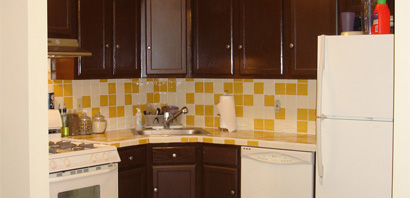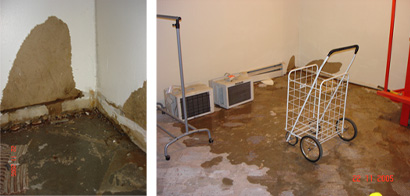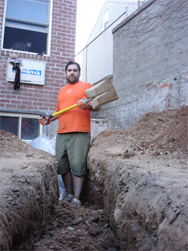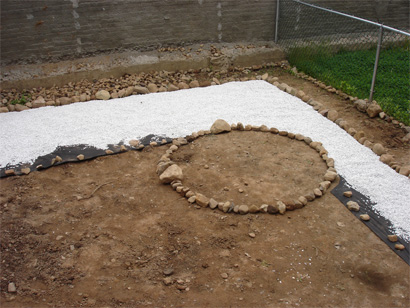What you are about to read is nothing new — and perhaps long. It is a mixture of two, maybe three, well-trotted subjects that in this writing relatively no new light will be shed. Instead, consider this an open therapy session where I lay on the couch and tell you about a set of realizations I have had — some that many already have had and accepted and after reading this will likely go “well, duh!” These realizations are the result of four months of arduous manual labor rooted in prior stubbornness, pride and context.
Let us take it from the top. For three and a half years I worked in a very small design firm in Chicago: We were four people, at times only two. We had two major clients that kept us busy and invoicing most of the time — that was good. We then had dozens of smaller clients that kept us busy for short periods of time and invoicing irregularly, if at all — that was not so good. We often struggled to reel in these small clients: Start-ups, one-man or small family-run operations with very little budgets for design services. We were the poster children of design under appreciation.
Classics like “I can do this cheaper at Kinko’s” and “I know a guy who works at home that can do this for half the price” were common and very real conclusions to our meetings or replies to our estimates. We lost a good number of potential clients to someone working at home and charging half the price. We hated these designers. Undermining us with their cheap pricing. At the other edge of reason, some clients felt we were too small, unable to accommodate their needs and bureaucracy and they would take their projects to bigger design firms. We hated these bigger design firms. Eclipsing us with their project managers and multiple-room offices. And we hated the clients for choosing either of these extremes and not us. Other times the client would just admit of taking matters into their own hands and designing the logo, brochure or web site themselves. We, of course, hated these clients too. Mocking us with their DIY, cheapskate attitude. Hated them. All of them.
Fast-forward to September 2005 and Bryony and I have become these clients. All of them. The cheapskate client, the — not as often as I would enjoy — let’s-just-spend-as-much-as-it-takes-to-get-it-right client and — most commonly — the DIY client. We bought a condo in Brooklyn that needed semi-major work. I was not prepared for what was about to come.
For our first encounter with a contractor we needed to make a hole in our basement through the foundation to install a vent for our washer/dryer. Based on a recommendation I called an Israel-born contractor who was all business. He was to charge $2,100 for the job. Twenty-fucking-hundred dollars for a fucking hole in the wall? For a few hundred bucks I could probably buy the stupid drill and make the hole myself. [Realization No. 1: I can perfectly imagine one of our small clients going “Four thousand fucking dollars for a stupid drawing? I can do this myself”]. We agree and the contractor shows up with two guys ready to drill a hole. The job is done efficiently and the result is beyond satisfying. The contractor returns and collects the money. Thinking that he is too expensive (but worth it) we agree that we will probably not call him again.
Our second encounter with a contractor comes through a recommendation from an electrician that has, to this day, been trying to fix the boiler that heats our house. This contractor is older, works alone, is a fellow Mexican and, music to our ears, is plenty cheaper. He comes in to drill yet another hole in our basement through the foundation — just below and to the left of the previous hole — to install a pipe and faucet so that we can use a hose in the backyard. It takes him a full weekend to do so. He is slow. But did I mention cheaper? He charges $1,200 for a hole, piping and some considerable re-sheetrocking. We like him. We give him more work through small jobs needed throughout the house. Not only is he affordable for our budget, he is actually quite nice and gives us a lot of attention. [Realization No. 2: This contractor is just like we were in Chicago, very appreciative of getting work, and going the extra mile to satisfy everyone involved. I also realize that we would rather spend less money on a slightly less efficient (but very competent) contractor than give work to a contractor that is more efficient but has another dozen, lucrative jobs he would prefer to tend to].
Up next was adding a door in the hallway. For this we turned to Lowe’s and Home Depot, the Landors of home improvement. Eventually we settled for Lowe’s where we paid around $1,400 for the whole thing. Here the process was long and boring. First, a guy had to come out and measure the hallway. A week later, an estimate came through. After approving it, it took around three weeks to get the installers to come. Once there, it was done quickly, efficiently, perhaps dryly — barely said good-bye when they left. [Realization No. 3: Working with the bigger fish gets the job done as you would expect, but it’s just a little too wham-bam-thank-you-ma’am for us. We agree that Home Depot and Lowe’s are to be used only in case of dire need].

One of our numerous trips to Home Depot. This one on a Friday night after work.
Our next project is tiling the kitchen countertop. We decide that we can handle this ourselves. Bryony does the necessary research and despite many Home Depot and Lowe’s employees telling us that we can’t, in our right minds, put tiles on a Formica countertop, that it will never stick, we roll our eyes at them and proceed as planned. [Realization No. 4: Ignoring advice from professionals is not as hard as it seems; if a client is convinced they can do something a certain way, they will do it with or without your help]. We spend a full day sanding, priming, putting down white sticky stuff, putting down tiles, putting in white puffy stuff between tiles and painfully cutting and trimming tiles with improper tools but we finish the job. Tired. Just one tile cracked and the edge of the countertop could be considered uneven. But we did it and we saved ourselves a good $2,000. [Realization No. 5: Why on earth give money to someone when you can do it yourself? Sure, it ain’t perfect, but no one will notice. I then think about all the poorly executed design out there — I notice. Good thing we don’t have contractor friends over for dinner regularly].

Left: Sanding every surface on the kitchen. Right: Ugly countertop.

Pretty countertop.
What comes next is a true testament to the DIY trend. From the moment we made our offer on the place we knew we wanted to get rid of the existing tile in the basement. A pale gray with red grout, unknown dirtiness and some side effects of flooding. Sometime in October we began the process by hammering the hell out of the tile. We bought a sledgehammer that I wielded semi-mightily. It took us about three weekends to loosen all the tile. Another weekend to take out the debris and clean the basement only to realize that the 650 square feet of basement was covered with little ridges left from the mortar — making it impossible to lay down a new, even set of tile. This seemed daunting. After doing research we came to the sad conclusion that only chisel and hammer would do the job. I implored Bryony to hire someone to do the dirty work. She didn’t budge. We spent all four weekends in January hammering out the ridges in 30 degree weather. Agony describes this process. With a smooth cement surface, (and bruises and blisters on our hands) we were ready to lay down the tile. I once again asked Bryony to pay someone to do this but Home Depot would have charged us over $10,000 (plus the cost of materials) and even our Mexican contractor would charge around $5,000. Both options required more money than we were willing to spend. The next four to six weekends were spent tiling. From morning to night. [Realization No. 6: At what point do I actually start losing money if I considered all this work as billable time? I could be doing other things. If, say, my hour was worth around $100 and worked 12 hours a weekend for six weeks I could be making $7,200. Does the inevitable slowness of doing alien things yourself become a bad business decision? Too bad hypothetical questions are hypothetical. I’ll never know].

Basement as it was when purchased.

Basement as it was when banged upon.

Basement as it was when flooded.
Sometime back in April we finished. We laid down 650 square feet of tile. Our knees purple and lower backs stiff. The tile is in place, crooked in some spots, but by golly we did it. The sense of satisfaction was beyond what I imagined. [Realization No. 7: With enough research, conviction and tools anyone can do pretty much anything, I mean, cavemen didn’t hire hunters to get that tatanka, they just went out and hunted the beast — a survival method. Why would it be any different with graphic design? The need to communicate triggers a survival method, perhaps not as dramatic as hunting, but with the right amount of determination budget-conscious clients can and will do things by themselves. And that’s alright].

Pointing at our progress.

Done!

A few spots where things don’t match. Equal to bad kerning I suppose.
We are currently in the process of changing the dark garage door that leads into the basement for a light and airy window door. This, to say the least, is beyond us. We are spending over $4,000 on this project and hiring our friendly Mexican contractor to do the job. We were willing to spend more for a speedier contractor but we thought it would be best to give the bigger project to someone that has taken a bunch of small, sometimes unchallenging jobs. Good thing we saved all that money on the tiling. [Realization No. 8: Back in Chicago, one of our two major clients decided to redesign all their corporate brochures, over 80 of them, many of which we had been helping produce for a long time. They gave the “creative” part of the project to a slightly bigger design firm and we were then handed templates to produce dozens of new brochures. This sucked. I didn’t want to be the client that didn’t have confidence in his service provider. Our guy can do it, perhaps slower but he can do it].
I had never been on the client side. I can’t say I understand all their quirks now, but at least I have an appreciation and respect for their concerns and requests: their trepidation to spend oodles of money on anything (specially a service like graphic design that seems so easy and painless to do), the hesitation to trust a stranger (of any size) with the message of their business or service, the agonizing of letting-go of the reigns… [Realization No. 9: Like their businesses, our house is an amalgam of expenses and dreams on a limited budget. We all get by as best as we can. We put our money where we think it’s best spent. We do things ourselves when we believe we can. I now — finally — understand that. The next time a small client decides to do things by themselves or hire a more affordable designer or a more staffed firm I won’t hate them… I will just put on my gloves and tackle the backyard].

Backyard as it was when we bought it. Weeds were 6 feet high.

Bryony took out most of the weeds. Arid ain’t it?

So arid it floods when it rains. Digging a ditch to create a home-made French drain.

Starting the prettyfication of the backyard.






Much appreciated, Armin.
I've been feeling some of the same lately, shopping around for the right vendors for our own projects. The balance becomes different when you're not spending your clients' money, but your own. Sadly, there's no way to DIY a water-based four-color job on FSC paper shipped climate cool. One day...
On May.26.2006 at 01:11 PM